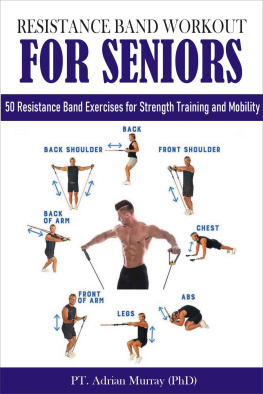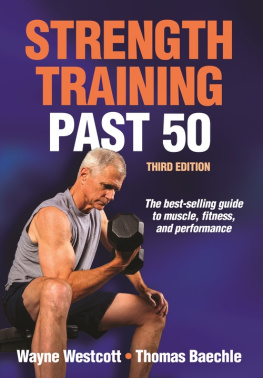RESISTANCE
TRAINING
FOR BEGINNERS
Copyright 2021by
All Rights Reserved.
This report aims to provide precise and robust information on the issue and issue secured. The output could be rendered with the prospect of the manufacturer not needing to do bookkeeping, officially licensed or otherwise eligible administrations. Should an exhortation be relevant, lawful, or qualified, a rehearsed individual in the call should be required.
The Statement of Principles approved and endorsed by the American Bar Association Committee and the Publications and Associations Commission.
It is not lawful to reproduce, copy, or distribute any portion of this study using either electronic methods or the community written. The registering of this delivery is deliberately disallowed, with the exception of written distributor authorization, the ability of this material is not permitted. All resources are retained.
The information provided is conveyed to be truthful and consistent, in so far as any chance, in the absence of thinking or something else, of any usage or misuse of any methods, procedures, or cookies found within is the special and definite responsibility of the receiver peruser. Any civil duty or liability shall be put upon the seller for any reparation, damage, or money-related misfortune attributable to the data received, whether explicitly or indirectly.
Those authors assert all copyrights which the seller does not retain.
The statistics herein are solely for instructional purposes and are all-. The details were reached without consent or acknowledgment of guarantee.
The markings used shall be without permission, and without the approval or the help of the proprietor of the label shall be published. All logos and trademarks in this book are for information purposes only and are held explicitly by individuals who are not affiliated with this document.
Contents
CHAPTER-1
What is resistance training ? 6
Why is it important to use weights ? 14
Lifting weights to gain strengt h 16
CHAPTER- 24
Fundamentals of resistance trainin g 25
The actions of muscles in resistance trainin g 31
Selection of exercise for the beginner s 37
CHAPTER- 46
Advanced resistance trainin g 48
Muscle damage and muscle recover y 54
The role of nutrition and slee p 60
ADDITIONAL RESOURCES
Workout and its name..67
Warmups & stretching.101
What is resistance training?
Resistance training is strength training used to increase muscular strength by working a muscle or a group of muscles against an external load. Resistance training is described as any activity that requires muscle contractions against such field strength to improve strength, capacity, muscle building, and stamina. Dumbbells, workout pipes, the own body mass, blocks, buckets of water, and any particular element that allows the muscles to stretch can be used as an external force. For long-term beneficial effects, maintenance programs are advised. Resistance therapy is more often associated with a healthier lifestyle than with a particular treatment intervention. There is currently no conclusive indication that any specific type of resistance training is by far the most appropriate for treating musculoskeletal disorders.
As a result, the key is to adapt your treatment to the particular person's needs next to you related to the evaluation. Resistance training is built on the concept because when movements are needed, they can counteract a swelling pressure. Resistance exercise comes in a variety of forms
There are three types of lifting :
- Athlete lifting (in which participants raise the mass upward as in the Olympic Games).
- Strength lifting (in which athletes do the jump, squat, deadlift, and pushups).
- Weight training (in which athletes raise big loads with less than six representatives).
Resistance training is where you carry loads at the fitness center to get heavier, taller, or more muscular. Weight training is sometimes synonymous with the expression "physical training." Logically, referring to resistance exercise like weight training is wrong. On the other hand, power training can be more aptly defined as physical activity that creates strength. The word resistance exercise will be used in this chapter to apply to any form of strength training you are doing in the fitness center to get stronger, heavier, more shapely, or improve your physical stamina.
How Would Resistance Training Work?
Resistance training operates by inflicting superficial harm or injuries on muscle fibers, which are quickly healed mainly through the system to support the muscle's recovery and development. Catabolism refers to the degradation of muscle fibers, while anabolism refers to the regeneration and regeneration of muscle cells.
Whenever it comes to steroids, you've always used the word anabolic. Anabolic involves "rising," and that's certainly understandable when physical activity breaks down muscle cells. Many biological mechanisms of development in the organism, in particular, necessitate any degradation or fatty acid oxidation after regenerate. For example, bones should first be decomposed so calcium and other growth regulators can rebuild and strengthen them.
Why do you need to do resistance training?
Resistance training does have health effects, and an emerging study shows that it would be an essential task for Westerners to participate in. Decades back, in predator cultures, individuals worked out their muscles by developing refuge, shooting, planting, and doing all the other menial work needed to survive. Presently, though, we designed passivity through our lifestyles with time-saving gadgets to the point that our limbs barely have to be moved hard. We do not even sweep leaves, hack turf, or clear frost by the arm; we wouldn't stand upright or perhaps even move around checkpoints (people moving companies do this! ); we do not even scrub our sheets, plates, and even drive a vacuum cleaner by hand.
It increases muscular strength and endurance. After the age of 30, people shed 5 lbs. of muscle per generation. Through aging, the individual muscle fiber decreases. We will lose over 25% of our fast-twitch muscle fibers between 30 and 70. (Type 2 fibers are our strength fibers). By increasing muscular weight and strength, resistance training can delay and even counteract the aging process. This has been shown to help develop bone. Osteoporosis, a disorder characterized by increased peak bone depletion that results in cracks, could be a debilitating illness, especially in women (but even though men are affected). Literature on strength training shows that this can develop bone sometimes in the aged. Strength training seems to help reduce relatively increased blood pressure. In the aged, increased intensity will progress to fewer crashes. Resistance training can improve the body's metabolism, which is necessary for bodyweight maintenance. It is never really late to catch up. Power rose by 113 percent in one survey of elderly individuals (say age 87) who started exercising three days a week for ten weeks.











